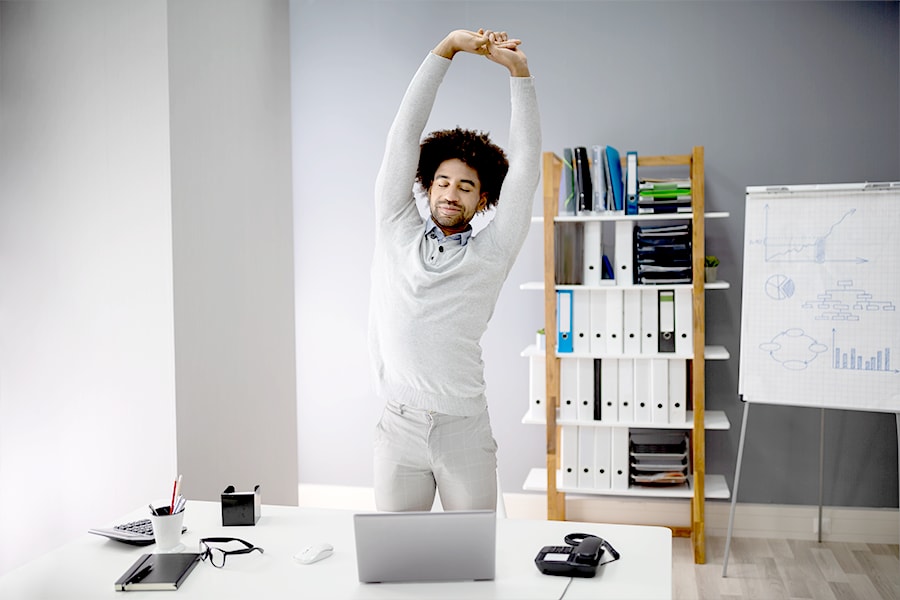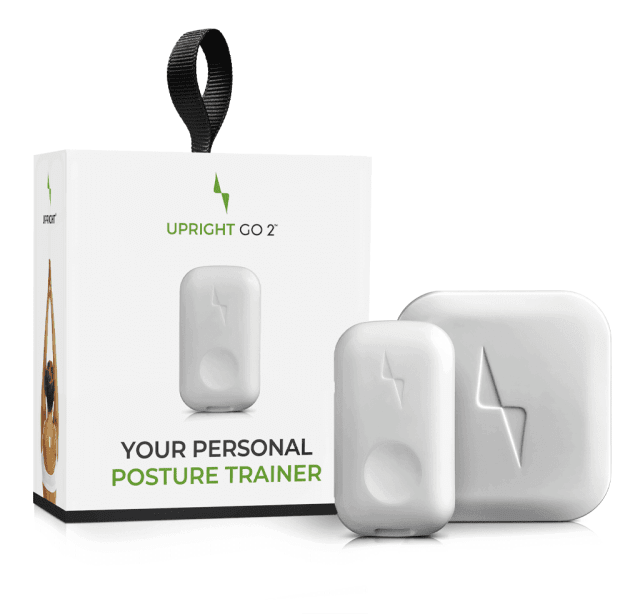Exercises To Improve Your Posture – Home Workout Guide
Max Frenkel

Looking to strengthen your body and improve your posture without a bulky back brace? Good news, we’ve compiled a list of 10 exercises to improve posture, 5 stretches and 5 strength training moves you can easily follow. As you get more comfortable, you are welcome to switch up the routine and add in more of your favorite steps.
Where do you start?
Commit to setting aside time on a daily or weekly basis to strengthen your body. Next, you’ll need to find some space in your home. You don’t need much room, but you do need enough to stretch in all directions. To test the space, stand in the center, stretch your arms straight out at your sides, and do a spin or two. If you don’t hit anything, you have enough room. Common spaces you might try are the space at the foot of your bed, an office that doubles as your hobby room, or a living room that allows you to slightly push back the couch. Once you’ve got your space and time, put on your workout clothes and grab a water bottle because you are ready to go.
Important Note: No one knows your body better than you do, so always work within your own range of limits and abilities. If you have any medical concerns, talk with your doctor before practicing any of the suggested exercises.
Don’t try to “work through” the pain, says Dr. Mark Kovacs, who has a doctoral degree in sports medicine and experience as a former tennis professional. “Those pain receptors are there for a reason.”
Stretching exercises to improve posture:
Stretching is a great way to loosen your muscles before a workout so you don’t strain anything, ease your muscles after intense exertion for optimal recovery, or to relax your body before bed. Try adding these stretches throughout your day or into your workout warm-up and cool down.
-
Child’s Pose
Child’s Pose helps to stretch the hips, thighs, and ankles while reducing stress and fatigue. It gently relaxes the muscles on the front of the body while softly and passively stretching the muscles of the back torso.
Be careful if you have a current or recent knee injury. If you are pregnant you should only practice a wide-legged variation of the pose — do not press the belly on top of the thighs.
-
Pelvic Tilt Stretch
Your pelvis helps you walk, run, and lift our weight off the ground. It also contributes to proper posture. Excessive sitting without enough movement and stretching could cause a state of what we call an anterior pelvic tilt, which is when your pelvis is rotated forward and forces your spine to curve.
-
Hip Flexor stretch
Hip flexor stretches are important to help counterbalance the prolonged hip flexion of sitting for hours. If left unstretched, shortened hip flexors affect the position of the pelvis, which in turn affects the position and movement of the lower back. And no one wants a tight or painful lower back.
-
Piriformis Muscle Stretch
First of all, what is your piriformis? The Piriformis is a muscle that lies in your buttocks and helps connect your spine to your legs. A tight piriformis from slouching in a chair with your hips rotated outward puts a lot of strain on your low back and makes your hips so tight that you can create an imbalance in the entire system.
-
Standing side stretches
This brings balance to your entire body. The stretch lengthens the abdominal muscles, hips, and thigh muscles while improving flexibility in the spine. Side bends also stretch the muscles between the ribs (the intercostal muscles). These muscles can get short and tight in daily life, due to too much time spent sitting or slouching. Stretching out the intercostals can also open up the ribcage and lungs, which will improve your breathing capacity.
Strengthening exercises to improve posture:
Strengthening exercises help build, tone, and sustain your muscles. By strengthening your core, back, and shoulders your muscles can better support your body in maintaining and improving posture. Over time you’ll want to increase your repetitions or intensity to provide the same strengthening effect.
-
Prone Back Extension
Performing the back extension exercise will increase your ability to coordinate movement through your lower back. Other improvements include a stronger back and a back that has more endurance. Overall, these positives lead to better overall back posture, important for the prevention of back injury.
Another variation of the back extension is holding the ‘arch’ position for a more extended period and performing fewer reps. Lift your feet and shoulders off the ground like the back extension, but place your arms either directly in front of you, reaching straight up from your shoulders; slightly angled out from your shoulders, in a ‘Y’ position, or straight out to your sides in a ‘T’ position. To add intensity you can pulse your arms in these positions, moving up and down for 30 seconds without coming back to the ground. This exercise is sometimes referred to as the ‘boat’ exercise because your body forms the shape of a rowboat.
-
Lying Lateral Leg Raises
This exercise is beneficial as it enhances posture, flexibility, balance, and limb speed. It involves many groups of muscles of your lower body: side hip flexors, thighs, glutes, hamstrings, calves, and obliques as well.
-
The Bird Dog
The bird dog is a simple core exercise that improves stability, encourages a neutral spine, and relieves low back pain. It strengthens your core, hips, and back muscles. It also promotes proper posture and increases range of motion.
-
Hollow Holds
The hollow hold works the body’s anterior chain — the muscles in the front of the body — including abs, diaphragm, hip flexors, and quads. In addition to building strength, stability, and body control, hollow holds boast back-friendly positioning by placing the body into a posterior pelvic tilt.
-
Dead Bug
Yes, that is the real name for this exercise, the dead bug is an excellent exercise for promoting total core stability while improving contra-lateral limb engagement. This basically means the exercise helps teach you to effectively move opposing limbs in tandem while keeping your core stable and your back protected. In other words, anyone who’s ever accidentally tripped on a rough sidewalk or been knocked off-balance after hitting into a misplaced chair knows that it doesn’t take much to lose control of your core.
I wish you all an UPRIGHT day 🙂
You Might also Like
Search
Sign up to our newsletter
Follow Us On
Popular
Revisit the GO 2/S Device Setup
How to get started
Finding your upright position
How to find your target upright posture
Calibration
Check out the UPRIGHT GO 2

